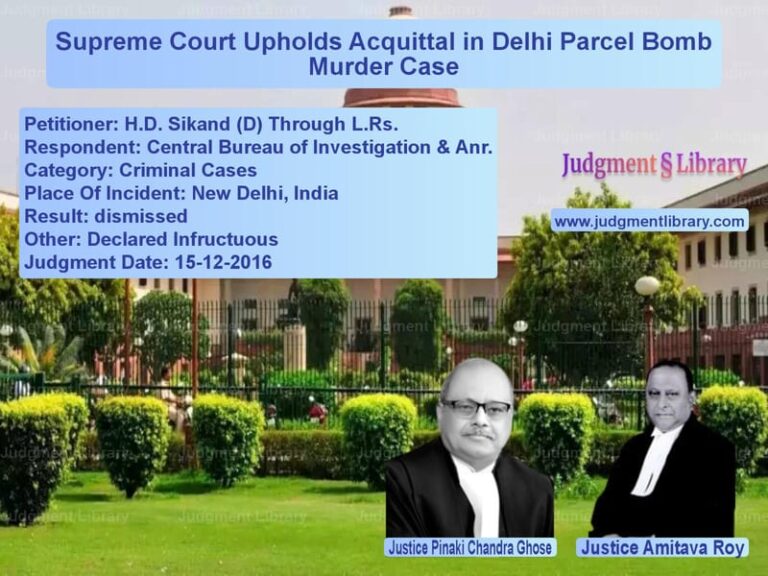Arbitration Act Interpretation: Supreme Court’s Ruling on Section 9 and Tribunal Powers
The case of Arcelor Mittal Nippon Steel India Ltd. vs. Essar Bulk Terminal Ltd. presents a significant legal question regarding the interplay between court intervention under Section 9 of the Arbitration and Conciliation Act, 1996, and the powers of an arbitral tribunal once constituted. The Supreme Court examined whether a court can entertain an application under Section 9(1) after an arbitral tribunal has been established and the extent to which courts must assess the efficacy of Section 17 as a remedy before intervening.
Background of the Case
The dispute between Arcelor Mittal Nippon Steel India Ltd. (Appellant) and Essar Bulk Terminal Ltd. (Respondent) arose from a cargo handling agreement for operations at Hazira Port. The agreement included an arbitration clause stating that disputes would be resolved through arbitration as per the Arbitration Act.
On November 22, 2020, the appellant invoked arbitration by issuing a notice to the respondent, which was met with no immediate response. The appellant then approached the Gujarat High Court under Section 11 of the Arbitration Act, seeking the appointment of an arbitral tribunal. On December 30, 2020, the respondent contested the arbitration claim, arguing that the disputes were not arbitrable and also raised claims amounting to Rs. 673.84 crores.
Key Legal Issues
- Whether courts can entertain applications under Section 9(1) after an arbitral tribunal is constituted.
- Whether courts must assess the efficacy of the remedy under Section 17 before granting interim measures.
- The meaning of the term “entertain” as used in Section 9(3) of the Arbitration Act.
Petitioner’s Arguments (Arcelor Mittal Nippon Steel India Ltd.)
The appellant contended:
- Section 9(3) restricts courts from entertaining applications for interim relief once an arbitral tribunal has been constituted.
- The purpose of the 2015 amendment to the Arbitration Act was to limit court intervention in arbitration proceedings.
- Since the arbitral tribunal had been constituted, the lower courts should not have proceeded with the Section 9 application.
- The term “entertain” in Section 9(3) should mean the entire process up to final adjudication, not just the admission of the application.
Respondent’s Arguments (Essar Bulk Terminal Ltd.)
The respondent opposed the appeal, arguing:
- The Section 9 applications had been fully heard, and only the pronouncement of orders was pending when the tribunal was constituted.
- Section 9(3) is neither an ouster clause nor a non-obstante provision and does not automatically bar courts from exercising jurisdiction.
- Since the applications were reserved for judgment before the tribunal was constituted, the court had already “entertained” them.
- The appellant was attempting to delay the proceedings and frustrate the purpose of the arbitration.
Supreme Court’s Judgment
The Supreme Court ruled that courts are not barred from completing the adjudication of Section 9 applications merely because an arbitral tribunal was constituted after the application was fully heard. The Court clarified that the term “entertain” in Section 9(3) means “considering an application on merits,” and once a court has commenced consideration, it retains the authority to decide the matter.
Key Observations:
“Section 9(3) does not operate to turn back the clock on matters where the application has already been entertained and arguments have concluded.”
“The objective of the 2015 amendment was to ensure that courts do not interfere unnecessarily when an arbitral tribunal is available. However, if an application has been taken up and heard, it does not become void upon the tribunal’s formation.”
Final Directions:
- The Gujarat High Court’s ruling was upheld with a clarification that the trial court was not required to reassess the efficacy of Section 17 in this case.
- The Commercial Court was directed to proceed with the adjudication of the Section 9 applications.
Impact of the Judgment
- Clarifies the interpretation of “entertain” under Section 9(3) of the Arbitration Act.
- Ensures that arbitration proceedings remain efficient while preserving the courts’ role in interim relief matters.
- Prevents unnecessary delays in arbitration due to procedural tactics.
- Upholds the autonomy of arbitral tribunals while allowing courts to complete matters already under consideration.
Conclusion
The Supreme Court’s ruling in Arcelor Mittal Nippon Steel India Ltd. vs. Essar Bulk Terminal Ltd. reinforces the balance between court intervention and arbitration autonomy. It upholds the legislative intent behind the Arbitration Act while ensuring that procedural fairness is maintained in pending matters. The decision serves as a crucial precedent in arbitration law, preventing litigants from using procedural gaps to derail arbitration proceedings.
Petitioner Name: Arcelor Mittal Nippon Steel India Ltd..Respondent Name: Essar Bulk Terminal Ltd..Judgment By: Justice Indira Banerjee, Justice J. K. Maheshwari.Place Of Incident: India.Judgment Date: 14-09-2021.
Don’t miss out on the full details! Download the complete judgment in PDF format below and gain valuable insights instantly!
Download Judgment: arcelor-mittal-nippo-vs-essar-bulk-terminal-supreme-court-of-india-judgment-dated-14-09-2021.pdf
Directly Download Judgment: Directly download this Judgment
See all petitions in Arbitration Act
See all petitions in Dispute Resolution Mechanisms
See all petitions in Enforcement of Awards
See all petitions in Institutional Arbitration
See all petitions in Judgment by Indira Banerjee
See all petitions in Judgment by J.K. Maheshwari
See all petitions in dismissed
See all petitions in supreme court of India judgments September 2021
See all petitions in 2021 judgments
See all posts in Arbitration and Alternate Dispute Resolution Category
See all allowed petitions in Arbitration and Alternate Dispute Resolution Category
See all Dismissed petitions in Arbitration and Alternate Dispute Resolution Category
See all partially allowed petitions in Arbitration and Alternate Dispute Resolution Category







